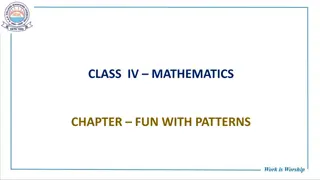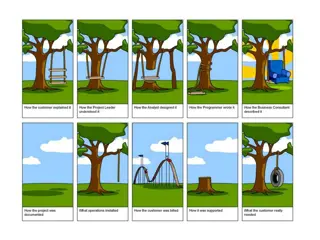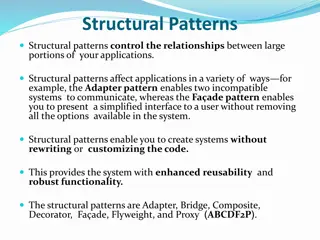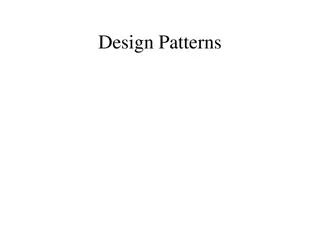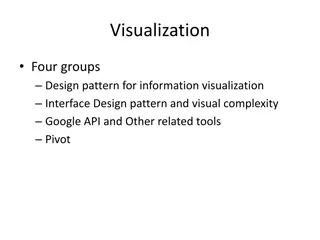Understanding Design Patterns: A Comprehensive Overview
Exploring the world of design patterns, this content delves into the essence of design patterns, their application in software design to resolve complexity, and the different types of design patterns - creational, structural, and behavioral. It also showcases examples of popular design patterns such as Strategy and Decorator, providing detailed insights into their implementation and usage in real-world scenarios.
Download Presentation

Please find below an Image/Link to download the presentation.
The content on the website is provided AS IS for your information and personal use only. It may not be sold, licensed, or shared on other websites without obtaining consent from the author. Download presentation by click this link. If you encounter any issues during the download, it is possible that the publisher has removed the file from their server.
E N D
Presentation Transcript
Design Patterns Rashed Fatehi
Introduction OOP? Resolve complexity? Why design patterns?
What is design pattern? Design patterns are typical solutions to common problems in software design.
The Catalog of Design Patterns Singelton Factory Method Abstract Factory Builder Prototype 1. Creational patterns: Provide various object creation mechanisms 2. 3. 4. 5. Adapter Facade Decorator (Wrapper class) Proxy Flyweight 1. Structural patterns: Explain how to assemble objects and classes into larger structures, while keeping these structures flexible and efficient 2. 3. 4. 5. Chain of responsibility Mediator Observer Proxy Strategy Template method 1. Behavioral patterns: Concerned with algorithms and the assignment of responsibilities between objects 2. 3. 4. 5. 6.
Strategy pattern interface IStrategy is method execute(a, b) class ConcreteStrategyAdd implements IStrategy is method execute(a, b) is return a+b class ConcreteStrategySubtract implements IStrategy is method execute(a, b) is return a-b class context is Strategy: IStrategy; method executeStrategy(int a, int b) is return strategy.execute(a, b)
Strategy pattern class ExampleApplication is method main() is Create context object. Read first number. Read last number. Read the desired action from user input. if (action == addition) then context.setStrategy(new ConcreteStrategyAdd()) if (action == subtraction) then context.setStrategy(new ConcreteStrategySubtract()) result = context.executeStrategy(First number, Second number) Print result
Decorator pattern (Wrapper class) class OddOrEvenDecorator implements IStrategy is Private _strategy: IStrategy; method executeStrategy(int a, int b) is return strategy.execute(a, b) method IsEven(int a) is return a % 2 == 0; method IsOdd(int a) is return a % 2 != 0;
Decorator pattern (Wrapper class) class ExampleApplication is method main() is Create context object. Read first number. Read last number. Read the desired action from user input. if (action == addition) then context.setStrategy(new OddOrEvenDecorator (new ConcreteStrategyAdd())) if (action == subtraction) then context.setStrategy(new OddOrEvenDecorator (new ConcreteStrategySubtract())) result = context. Strategy.IsOdd(First number) Print result
Factory method pattern abstract class AbstractDialog is abstract method createButton():Button method render() is Button okButton = createButton() okButton.render() class WindowsDialog extends AbstractDialog is method createButton():Button is return new WindowsButton() class WebDialog extends AbstractDialog is method createButton():Button is return new HTMLButton()
Factory method pattern class Application is field dialog: AbstractDialog method initialize() is config = readApplicationConfigFile() if (config.OS == "Windows") then dialog = new WindowsDialog() else if (config.OS == "Web") then dialog = new WebDialog() else throw new Exception("Error! Unknown operating system.") method main() is this.initialize() dialog.render()
Singelton pattern Class Database is private static field instance: Database private constructor Database() is //Some Initiolization code public static method getInstance() is if (Database.instance == null) then acquireThreadLock() and then if (Database.instance == null) then Database.instance = new Database() return Database.instance
Refrences Why is OOP Such a Waste?. A waste of time of money. | by Ilya Suzdalnitskiy | Medium Design Patterns (refactoring.guru) Author, Eric Freeman & Author, Elisabeth Robson & Author, Bert Bates & Author Kathy Sierra (2004).Head First Design Patterns. Location: O'Reilly









